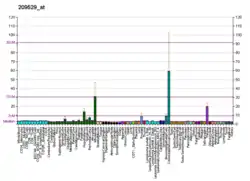| PLPP2 | |||||||||||||||||||||||||||||||||||||||||||||||||||
|---|---|---|---|---|---|---|---|---|---|---|---|---|---|---|---|---|---|---|---|---|---|---|---|---|---|---|---|---|---|---|---|---|---|---|---|---|---|---|---|---|---|---|---|---|---|---|---|---|---|---|---|
| Identifiers | |||||||||||||||||||||||||||||||||||||||||||||||||||
| Aliases | PLPP2, LPP2, PAP-2c, PAP2-g, PPAP2C, Phosphatidic acid phosphatase 2c, phospholipid phosphatase 2 | ||||||||||||||||||||||||||||||||||||||||||||||||||
| External IDs | OMIM: 607126 MGI: 1354945 HomoloGene: 2752 GeneCards: PLPP2 | ||||||||||||||||||||||||||||||||||||||||||||||||||
| |||||||||||||||||||||||||||||||||||||||||||||||||||
| |||||||||||||||||||||||||||||||||||||||||||||||||||
| |||||||||||||||||||||||||||||||||||||||||||||||||||
| |||||||||||||||||||||||||||||||||||||||||||||||||||
| |||||||||||||||||||||||||||||||||||||||||||||||||||
| Wikidata | |||||||||||||||||||||||||||||||||||||||||||||||||||
| |||||||||||||||||||||||||||||||||||||||||||||||||||
Lipid phosphate phosphohydrolase 2 is an enzyme that in humans is encoded by the PPAP2C gene.[5][6][7]
The protein encoded by this gene is a member of the phosphatidic acid phosphatase (PAP) family. PAPs convert phosphatidic acid to diacylglycerol, and function in de novo synthesis of glycerolipids as well as in receptor-activated signal transduction mediated by phospholipase D. This protein is similar to phosphatidic acid phosphatase type 2A (PPAP2A) and type 2B (PPAP2B). All three proteins contain 6 transmembrane regions, and a consensus N-glycosylation site. This protein has been shown to possess membrane associated PAP activity. Three alternatively spliced transcript variants encoding distinct isoforms have been reported.[7]
References
- 1 2 3 GRCh38: Ensembl release 89: ENSG00000141934 - Ensembl, May 2017
- 1 2 3 GRCm38: Ensembl release 89: ENSMUSG00000052151 - Ensembl, May 2017
- ↑ "Human PubMed Reference:". National Center for Biotechnology Information, U.S. National Library of Medicine.
- ↑ "Mouse PubMed Reference:". National Center for Biotechnology Information, U.S. National Library of Medicine.
- ↑ Leung DW, Tompkins CK, White T (May 1998). "Molecular cloning of two alternatively spliced forms of human phosphatidic acid phosphatase cDNAs that are differentially expressed in normal and tumor cells". DNA Cell Biol. 17 (4): 377–85. doi:10.1089/dna.1998.17.377. PMID 9570154.
- ↑ Hooks SB, Ragan SP, Lynch KR (Jun 1998). "Identification of a novel human phosphatidic acid phosphatase type 2 isoform". FEBS Lett. 427 (2): 188–92. doi:10.1016/S0014-5793(98)00421-9. PMID 9607309. S2CID 31610109.
- 1 2 "Entrez Gene: PPAP2C phosphatidic acid phosphatase type 2C".
Further reading
- Nanjundan M, Possmayer F (2003). "Pulmonary phosphatidic acid phosphatase and lipid phosphate phosphohydrolase". Am. J. Physiol. Lung Cell Mol. Physiol. 284 (1): L1–23. doi:10.1152/ajplung.00029.2002. PMID 12471011.
- Morris KE, Schang LM, Brindley DN (2006). "Lipid phosphate phosphatase-2 activity regulates S-phase entry of the cell cycle in Rat2 fibroblasts". J. Biol. Chem. 281 (14): 9297–306. doi:10.1074/jbc.M511710200. PMID 16467304.
- Gerhard DS, Wagner L, Feingold EA, et al. (2004). "The status, quality, and expansion of the NIH full-length cDNA project: the Mammalian Gene Collection (MGC)". Genome Res. 14 (10B): 2121–7. doi:10.1101/gr.2596504. PMC 528928. PMID 15489334.
- Strausberg RL, Feingold EA, Grouse LH, et al. (2003). "Generation and initial analysis of more than 15,000 full-length human and mouse cDNA sequences". Proc. Natl. Acad. Sci. U.S.A. 99 (26): 16899–903. Bibcode:2002PNAS...9916899M. doi:10.1073/pnas.242603899. PMC 139241. PMID 12477932.
- Zhang N, Sundberg JP, Gridley T (2000). "Mice mutant for Ppap2c, a homolog of the germ cell migration regulator wunen, are viable and fertile". Genesis. 27 (4): 137–40. doi:10.1002/1526-968X(200008)27:4<137::AID-GENE10>3.0.CO;2-4. PMID 10992322. S2CID 24643785.
- Roberts R, Sciorra VA, Morris AJ (1998). "Human type 2 phosphatidic acid phosphohydrolases. Substrate specificity of the type 2a, 2b, and 2c enzymes and cell surface activity of the 2a isoform". J. Biol. Chem. 273 (34): 22059–67. doi:10.1074/jbc.273.34.22059. PMID 9705349.
This article is issued from Wikipedia. The text is licensed under Creative Commons - Attribution - Sharealike. Additional terms may apply for the media files.




